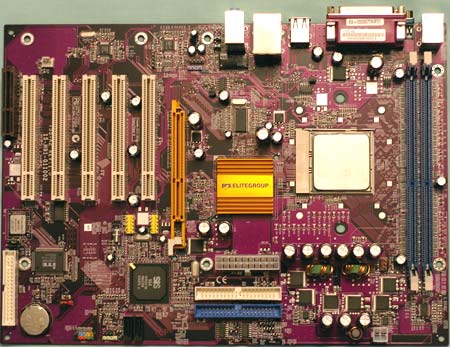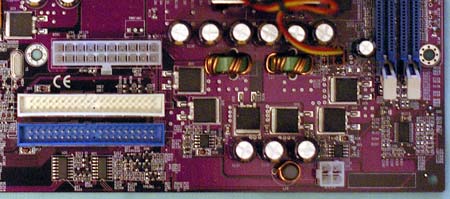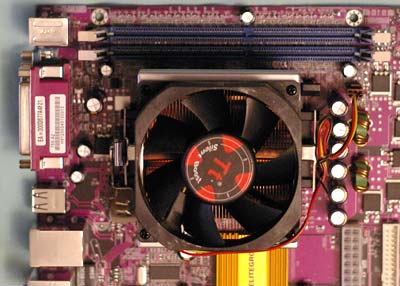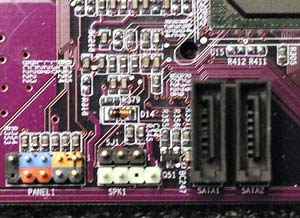ECS 755-A2: Performance and Value for the Athlon 64
by Wesley Fink on January 30, 2004 8:51 AM EST- Posted in
- Motherboards
ECS 755-A2: Board Layout
The ECS 755-A2 is a little less than full-size, mounting in the case with 2 rows of standoffs instead of the 3 seen on full-size ATX boards. This should make it an easy fit in almost any case. The disadvantage is that the smaller size often requires compromises in component placement.
The 755-A2 is the same dark plum color used on the 755-A. Like the SiS 755 Reference Board, the processor socket is turned and the DIMM slots are placed at the very top of the board. Most heatsinks have fins arranged across the short dimension of the 754 socket, including AMD's own HSF included in retail CPU kits. With heat rising, this places the DIMMs in the hottest position on the board in a common tower case. This did not present a problem in our testing, but should be kept in mind when cooling a system based on the 755-A2.
The ECS only has two 3-pin fan connectors. Those hoping to add an active North Bridge cooling solution will not find a fan connection near the 755 chip. With many power supplies having a 3-pin monitoring connection for the power supply, another fan connection would be welcomed. The CPU fan connector is near the CPU socket, but the only other connector is between the 5 PCI slots and the backplane.

The 755-A2 is single-channel Socket 754, so it only requires one DIMM. However, most Socket 754 boards provide 3 DIMM slots. With the many problems that we have found with actually using 3 DIMMs on Athlon 64 boards, including just 2 DIMMs will not likely compromise memory expansion and probably cuts down on Technical Support calls to ECS. The maximum memory capacity is the same 2GB as in other boards, and two 1GB DIMMs can reach that maximum.

Unlike Athlon XP motherboards, the Athlon 64 and FX51 boards that we have seen use a standardized ATX plus 12V connector arrangement. This is identical to the power connector requirements of current Pentium 4 systems. ECS places the connectors in the preferred upper right of the board. In general, the arrangement of external connectors along the right edge of the board should work well in most cases.
The board appears to be a 3-phase design, based on the 6 power transistors used, but with only 2 coils we are not sure. There were no problems with power regulation in our testing.

While there was no problem fitting a standard heatsink/fan like the AMD Athlon 64 retail HSF, the memory sockets are too close to the CPU to mount a large HSF like the Zalman. The very tall capacitors to the right of the socket could also block some of the larger HSF designs. We suggest that you look carefully at the available space if you plan to mount a very large HSF on the 755-A2.

The Primary/Secondary IDE connectors are all in our preferred position, above the midline of the board and to the right of the board. This position on the top right edge of the board works well with cable arrangements in almost any case. With the 20-pin ATX connector located between the IDE connectors and the North Bridge, it is easier to first connect the IDE, then the bulky ATX power cable.

It is difficult to see in a picture, but the ECS SATA connectors are much better than we usually see. The fragile SATA connectors are in a full socket that makes accidentally stressing the connector and breaking off the connector a lot less likely. With frequent board and cable swapping, you come to appreciate how fragile the SATA connector design really is. We've actually broken connectors on 4 SATA drives/boards so far compared to none with many IDE drives. The ECS socket design looks much sturdier. SATA hard drive manufacturers should really take a close look at this socket design.
While this is definitely a value board, ECS still includes a color-coded front panel connector to make identifying connections a little easier.

Unfortunately, the floppy connector is located on the lower right of the board. This will work fine in some case designs, but it will be a difficult reach in large tower cases. This location can also make neat cabling difficult in most cases. In fairness to ECS, this placement is carried over from the SiS 755 Reference design. While smaller than the Reference board, the 755-A2 follows the reference design, including both the good and the bad. It will be interesting to see what Asus does in the layout of their 755 board.

ECS includes 5 PCI slots, an 8X AGP, and a CNR slot. With memory at the top of the board, there is no concern about interference with the AGP slot. The slot area was well thought out, with little to interfere with mounting expansion cards.










14 Comments
View All Comments
Glenngalata - Saturday, June 5, 2004 - link
While the review on this board is well written, the overall statements made on the quality of the motherboard and the RMA process is extremely generous to say the least.ECS motherboards (and the company) are by far the most difficult to work with due to the total lack of reasonable support the company gives to its customers.
All top tier manufacturers are moving to 3 year warranties unlike ECS whose 1 year offering is a clear indictation of "buy at your own risk" marketing.
Asus allows the end user to deal directly with the company for RMA purposes and this feature alone is worth any price premium over a throw away prodcut line.
The author is being very kind in many areas of the ECS/Customer relationship and at this point in time i have spent more time, frustration and money on long distance phone calls trying to deal with a manufacturer who simply does not acknowlege its own shortcomings product and service wise.
You get what you pay for and if the manufacturer does not give a direct end user oriented,3 year warranty deal, stay clear and spend the extra for some peace of mind.
Memn0ch - Monday, April 26, 2004 - link
Do you want ECS 755-A2 as a freebie?http://www.ocworkbench.com/ocwb/ultimatebb.php?ubb...
gglawits - Tuesday, March 30, 2004 - link
I saw the 755-A2 at Newegg yesterday. For $90, if memory serves.Cheers,
Greg
justly - Sunday, February 1, 2004 - link
I do understand your aggravation with the 755-A, the thing is this article is not about the 755-A is it.If you want to call the 755-A2 a POS then lets not stop there, lets also claim ATi drivers are just as bad now as they ever where, or that AMD will always be subpar to Intel in performance.
Don't get me wrong, I am not condoning ECS for putting out a product that obviously did not have enough testing, or for changing their website.
As for the claim that the 755-A does not support DDR 400, that may be true, but as long as the possibility exists that it can work with at least one brand of DDR 400 at DDR 400 speeds that conclusion can only be considered theory not fact. Does that mean that the 755-A is a good product, absolutely not.
Since you brought up a car analogy I will try to use it even though I normally try to avoid them since they often use bogus/exaggerated information. With that in mind you need to consider that Chevy may do their testing to get the best HP rating possible. This means Chevy could test using a new air filter, premium gasoline, new oil and filter and even at a specific ambient temp and relative humidity ect.ect... so unless everything is configured exactly the same a lower HP will result, it may not be much, but if Chevy does this they can make the HP rating accurate, but never obtainable in real life.
Does Chevy do this, it wouldn't surprise me if they did. Did ECS do something similar with the 755-A, maybe. Was it done on purpose, I doubt it. Was it poor judgment on ECS part, yes. Do I think this is user error, definatly not, its obvious you have a lot of experiance. Did you get duped into buying a subpar product, yes. Do I think all this talk about the 755-A belongs here or on the regular fourms, considering this is a direct link from a article about the 755-A2 I would say most if not all the comments about the 755-A belongs on the regular forums, at least that is my opinion.
NFS4 - Saturday, January 31, 2004 - link
Justly, the point is not that board was just "buggy", it simply doesn't have what they EXPLICITY stated was a supported feature of the board.(1) They said that the 755-A supported DDR400 memory on their website.
(2) Vendors and other venues stated that the board supported DDR400
(3) The BIOS had setting for DDR400 memory speeds.
(4) The motherboard box says RIGHT THERE IN PLAIN ENGLISH that it supports DDR400.
Then when you try to test the board, it's only running at DDR333 speeds despite if you're using DDR400 or higher memory. And the only thing that ECS does is drop the specs down to DDR333 on their website instead of issuing a statement saying that their board doesn't work as advertised.
It'd be all the same if Chevy announced that their C6 Corvette has 400 HP at the wheels. The dealers list that spec as well. Customers go and buy a C6 and notice that performance is down a bit. They put their car on a dyno and it's making 350HP at the wheels instead. This result is then repeated by countless others that have purchased C6's.
And I SHOULDN'T have to use a hacked BIOS to get it to work either.
justly - Saturday, January 31, 2004 - link
I don't see the reason to bash the 755-A2 just because of the troubles that people had with the 755-A. The 755-A was the very fist production board that used the SIS chipset.Since when did first production run of anything not have quirks or room for improvement. Granted, the 755-A may have had more quirks than most. The thing is you can argue this from both sides. My take on the 755-A is that any enthusiast that expects top of the line, trouble free performance with the least expensive motherboard available (and the first production run of that board to boot) is betting on a long shot, and is bound to loose in most cases. Sorry if I offended anyone.
As for the 755-A2 it looks like a decent option IMO, although it maybe never be the perfered choice for the hardcore enthusiast.
Wesley Fink - Saturday, January 31, 2004 - link
AMDMB and others have flashed the A2 BIOS to Rev A boards and found that DDR400 then works fine. The mod in the ECS Forum there has his basic Samsung memory now running at DDR432 after the flash. He also reports the memory timings from the 12/25 A2 are now on his Rev A and they work fine.In addition a BIOS modder has uncovered hidden vCore adjustments and additional options in the 12/25 A2 BIOS. You can find tne 12/25 BIOS at the AMDMB Forums ECS Forum at http://forums.amdmb.com/showthread.php?s=&thre... I am told the modded BIOS will also post there soon.
NFS4 - Saturday, January 31, 2004 - link
KillaKilla, I got a Biostar NF3 board from ZipZoomFlyTrogdorJW - Saturday, January 31, 2004 - link
This board is a perfect example of why 64-bit is really meaningless for the most part. Two DIMM slots? Not that it really matters, since pretty much all of the other A64 motherboards have issues with populating all three DIMM slots anyway.The reason to buy Athlon 64 is that it's faster (and cheaper, relative to the 3.0 and 3.2 GHz P4 chips) in 32-bit software. (Just purchased parts for a 3000+ for a friend - I'll be building it this weekend.) 64-bit software will come during the life of the PC, sure, but you definitely won't need to switch to 64-bit anytime soon. Unless youre running into memory limitations, in which case you better be prepared to pony-up for the Opteron or Athlon FX!
As for ECS, I've only used two of their motherboards in my PC building life, and neither one impressed me. They may work okay, but I question the long-term choice of their boards over MSI, Asus, A-bit, etc. The 755-A was a prime example of why I no longer consider ECS boards an option. On the bright side, they're usually hella cheap. (And you get what you pay for....)
KristopherKubicki - Friday, January 30, 2004 - link
Unfortunately since we have labs all over the country we try to standardize as much as possible. Even though Wesley used a 9800 Pro, he used the same testbed that Anand, Derek and Evan use - we eliminate as many variables as possible.Kristopher